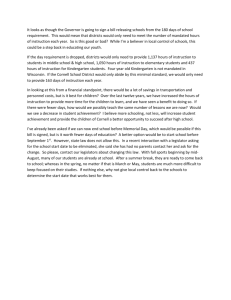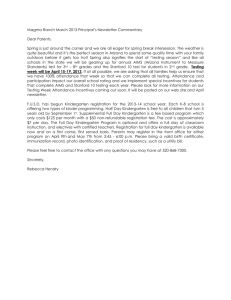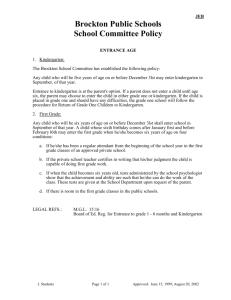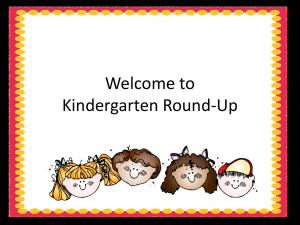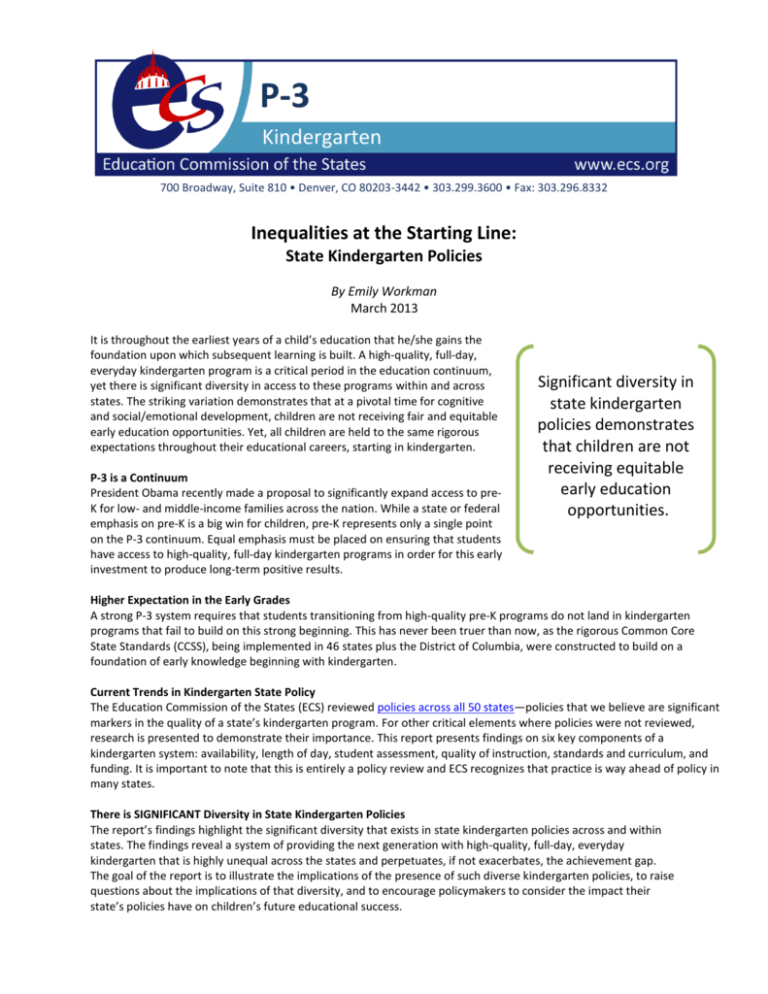
P-3
Kindergarten
700 Broadway, Suite 810 • Denver, CO 80203-3442 • 303.299.3600 • Fax: 303.296.8332
Inequalities at the Starting Line:
State Kindergarten Policies
By Emily Workman
March 2013
It is throughout the earliest years of a child’s education that he/she gains the
foundation upon which subsequent learning is built. A high-quality, full-day,
everyday kindergarten program is a critical period in the education continuum,
yet there is significant diversity in access to these programs within and across
states. The striking variation demonstrates that at a pivotal time for cognitive
and social/emotional development, children are not receiving fair and equitable
early education opportunities. Yet, all children are held to the same rigorous
expectations throughout their educational careers, starting in kindergarten.
P-3 is a Continuum
President Obama recently made a proposal to significantly expand access to preK for low- and middle-income families across the nation. While a state or federal
emphasis on pre-K is a big win for children, pre-K represents only a single point
on the P-3 continuum. Equal emphasis must be placed on ensuring that students
have access to high-quality, full-day kindergarten programs in order for this early
investment to produce long-term positive results.
Significant diversity in
state kindergarten
policies demonstrates
that children are not
receiving equitable
early education
opportunities.
Higher Expectation in the Early Grades
A strong P-3 system requires that students transitioning from high-quality pre-K programs do not land in kindergarten
programs that fail to build on this strong beginning. This has never been truer than now, as the rigorous Common Core
State Standards (CCSS), being implemented in 46 states plus the District of Columbia, were constructed to build on a
foundation of early knowledge beginning with kindergarten.
Current Trends in Kindergarten State Policy
The Education Commission of the States (ECS) reviewed policies across all 50 states—policies that we believe are significant
markers in the quality of a state’s kindergarten program. For other critical elements where policies were not reviewed,
research is presented to demonstrate their importance. This report presents findings on six key components of a
kindergarten system: availability, length of day, student assessment, quality of instruction, standards and curriculum, and
funding. It is important to note that this is entirely a policy review and ECS recognizes that practice is way ahead of policy in
many states.
There is SIGNIFICANT Diversity in State Kindergarten Policies
The report’s findings highlight the significant diversity that exists in state kindergarten policies across and within
states. The findings reveal a system of providing the next generation with high-quality, full-day, everyday
kindergarten that is highly unequal across the states and perpetuates, if not exacerbates, the achievement gap.
The goal of the report is to illustrate the implications of the presence of such diverse kindergarten policies, to raise
questions about the implications of that diversity, and to encourage policymakers to consider the impact their
state’s policies have on children’s future educational success.
The Importance of Availability
Availability
Length of Day
Student
Assessment
Quality of
Instruction
Standards/
Curriculum
Funding
What We Found
Districts must offer kindergarten
11 states plus D.C. require districts to
offer full-day kindergarten.
34 states require districts to offer halfday kindergarten.
Five states do not require districts to
offer kindergarten, leaving the decision
to school districts.
Children must attend kindergarten
15 states plus D.C. mandate
kindergarten attendance.
35 states do not require that children
attend kindergarten.
Why it Matters
Benefits of kindergarten attendance
are clearly supported by research.
The CCSS are built on a strong
foundation that begins in kindergarten.
Early literacy and mathematics skillbuilding, and social/emotional competencies are critical for later proficiency and school success.
Critical Decision Points
Are sufficient high-quality, full-day kindergarten programs available for students?
Are full-day programs offered every day?
Will parents have the option to enroll their child in a full-day program?
Are students required to attend kindergarten?
Do districts receive state funding for half-day only or full-day? Does the funding formula need to be
revisited?
Is access to kindergarten programs free of charge? Are parents charged tuition if they choose to send
their children to full-day programs?
Are districts authorized to contract with another district or outside provider for kindergarten programs?
Education Commission of the States • 700 Broadway, Suite 810 • Denver, CO 80203-3442 • 303.299.3600 • fax 303.296.8332 • www.ecs.org
Page 2
Length of Day: What Constitutes a Kindergarten Program?
Availability
Length of Day
Student
Assessment
Quality of
Instruction
Standards/
Curriculum
Funding
What We Found
Minimum Hours States Must Offer
Kindergarten*
20
# of States
Most discussion of kindergarten policy centers
on whether programs are half-day or fullday—and most policymakers are probably
unaware of the significant discrepancies in
instructional time within and across states,
1
whether half-day or full-day programs.
State requirements for half-day
programs range from a minimum of
two hours to three-and-a-quarter
hours per day.
Requirements for full-day programs
range from a minimum of four hours to seven
hours per day.
Why it Matters
15
10
States
5
0
2 2.5 3 3.5 4 4.5 5 5.5 6 6.5 7 * Hours per day rounded up
Hours per Day
Half-Day
to the nearest half hour
Full-Day
Kindergarten is an essential part of the foundation upon which future learning and social/emotional
development is built.
Students in one school district might receive more than three times the learning and developmental
opportunities than those in a neighboring district. This is an equity and effectiveness issue.
With the introduction of the CCSS, all kindergarten students will be expected to meet the same rigorous
standards whether they spend two hours or six hours per day in the classroom.
For students who attend high-quality preschool programs, offering continuity in the number of hours they
spend in a classroom each year thereafter will avoid disrupting schedules, and support working families so
that they do not need to continually adjust childcare arrangements.
Critical Decision Points
Are students expected to attend kindergarten for the same amount of time every day?
Is the length of the kindergarten day providing sufficient opportunity for deeper learning?
How can the school funding formula provide districts with incentives to increase enrollment and expand
full-day, every day kindergarten programs?
Are minimum hours well-aligned to the hours required in pre-K and 1st-grade classrooms?
Education Commission of the States • 700 Broadway, Suite 810 • Denver, CO 80203-3442 • 303.299.3600 • fax 303.296.8332 • www.ecs.org
Page 3
Kindergarten Entry Assessments
Availability
Length of Day
Student
Assessment
Quality of
Instruction
Standards/
Curriculum
Funding
An increasing number of states require the administration of kindergarten entry assessments. The primary purpose
of kindergarten assessments is to offer teachers and administrators a tool to support the development of
appropriate instructional practices, identify students requiring additional supports, and to ensure that pre-K
programs are adequately preparing students for the rigors of kindergarten. Nonetheless, further evidence on the
effect of kindergarten entry assessments on student achievement is needed.
What We Found
25 states plus D.C. currently require the administration of a kindergarten entry assessment.
o 14 states plus D.C. use a state-developed kindergarten entry assessment.
o 11 states require districts to develop and administer local kindergarten entry assessments.
Four states are in the process of developing a kindergarten entry assessment, expected in 2014.
Why it Matters
Kindergarten entry assessments can be used to:
Identify strengths and needs of young children
Predict the need for additional supports for children
Inform teachers, improve classroom instruction, and ensure services are made available to students
Indicate whether pre-K programs are aligned with school expectations (K-3).
Key Decision Points
How is readiness for kindergarten defined?
Are the assessments developmentally appropriate and do they capture social, emotional, and behavioral
development of students?
Is a particular assessment tool required? How does state policy influence selection of assessments? Are
assessment choices nationally normed?
At what time or intervals throughout the year are the assessments administered, and who administers
them?
For what purpose is the assessment used?
Is the assessment aligned to standards and curriculum?
What are the costs of creating, administering and evaluating results in time and dollars? Does it produce a
positive return on investment?
Education Commission of the States • 700 Broadway, Suite 810 • Denver, CO 80203-3442 • 303.299.3600 • fax 303.296.8332 • www.ecs.org
Page 4
Quality of Instruction: The Classroom – Class Size
Availability
Length of Day
Student
Assessment
Quality of
Instruction
Standards/
Curriculum
Funding
What We Found
Lowest maximum teacher/student ratio specified in law is 1:15.
Highest maximum ratio is 1:30.
Some states specify ratios if an aide or teaching assistant is in the classroom, ranging from 2:20 to 2:30.
Why it Matters
Although research is mixed in its support for smaller class sizes, for early grades and students from lowincome families, evidence supports the premise that smaller class size contributes to student
achievement.
Key Decision Points
What evidence is being used to determine the optimal class size for kindergarten or P-3 classrooms?
Are there enough qualified teachers available to meet the needs of smaller class size and therefore more
kindergarten classrooms?
What is the evidence for using aides as a less-costly support for teachers assigned to larger classes so that
teachers are freed up to focus solely on instruction?
#of States
Maximum Teacher/Student Ratios
9
8
7
6
5
4
3
2
1
0
States
1:15 1:17 1:18 1:20 1:21 1:22 1:23 1:24 1:25 1:30
Teacher/Student Ratios
Education Commission of the States • 700 Broadway, Suite 810 • Denver, CO 80203-3442 • 303.299.3600 • fax 303.296.8332 • www.ecs.org
Page 5
Quality of Instruction: Teacher Preparation, Licensure, and Professional
Development
Availability
Length of Day
Student
Assessment
Quality of
Instruction
Standards/
Curriculum
Funding
Effective teacher preparation, licensure, and professional development are critical components of a P-3 system.
Research shows that the developmental needs of students in early childhood education are unique to that age
group, and specialized training is required for teachers to fully understand how young children learn and to gain
2
the skills needed to teach in ways that are developmentally appropriate. Teacher preparation programs should
offer separate tracks for teachers planning to work in the early grades, and the use of P-3 licensing that documents
skills in teaching early literacy and mathematics as well as a deep understanding for the social/emotional needs of
young children can help ensure that early grade teachers are well-prepared to meet the needs of that age group.
Although some states offer a P-3 license, many school leaders prefer that their staff hold a K-6 or K-8 license
because it provides them with maximum flexibility in teacher placement. This is an area ripe for deeper discussion
and research.
Coupled with teacher preparation and certification, an essential element to ensuring high instructional quality is
the availability of ongoing, effective professional development. High-quality teacher training and education should
not end when a teacher enters the classroom.
Why it Matters
The cognitive, social/emotional, and behavioral needs of kindergarten students are unique, and teachers
working with that age group need to be prepared and well-trained to meet their needs.
Teachers who lack the critical knowledge or skills for teaching young children too often find themselves
assigned to kindergarten classrooms, resulting in instruction that may be developmentally inappropriate.
Critical Decision Points
Are teacher preparation programs effectively preparing teachers who will work in a P-3 environment?
Does the current license reflect a strong preparation base for teaching young children?
Is a P-3 license available, and is it a requirement for teaching in a P-3 setting?
Is professional development tailored to the needs of P-3 teachers and students? Is it provided?
Are there resources available for effective professional development?
Source: Center for Advanced Study of Teaching and Learning, Measuring and Improving Teacher-Student Interactions in PK-12
Settings to Enhance Students’ Learning (Charlottesville, Virginia: Center for Advanced Study of Teaching and Learning, 2011).
Education Commission of the States • 700 Broadway, Suite 810 • Denver, CO 80203-3442 • 303.299.3600 • fax 303.296.8332 • www.ecs.org
Page 6
State Standards and Developmentally Appropriate Curriculum
Availability
Length of Day
Student
Assessment
Quality of
Instruction
Standards/
Curriculum
Funding
Making full-day kindergarten accessible to all is the first step, but not a sufficient step. The quality of a
kindergarten experience is fundamental to the ultimate impact on children and their success in school and in life.
To ensure quality, state standards need to be aligned across the P-3 continuum, curricula that support the
standards need to be of high-quality and developmentally appropriate, and quality of individual programs needs to
3
be evaluated. Developmentally appropriate means that kindergarten programs should not simply emphasize basic
skills, but help children build their physical, social/emotional, and intellectual capabilities through exploration and
4
play.
Most states have early learning standards, but the degree to which they have been integrated with the Common
Core or high-quality curricula is far less clear. In order to be successful in kindergarten, students must be given the
opportunity to master the expectations set forth for them in the standards. High-quality curricula are essential in
achieving this goal.
Why it Matters
Student capacity for growth and learning is significant in the early years.
Documented, common expectations will provide teachers with roadmaps and benchmarks to tailor to
developmentally appropriate lessons.
Expectations of deeper learning by the end of kindergarten have greatly increased with the introduction
of the Common Core.
Deeper learning does not equate to “less play” or playful learning activity. Attention needs to be paid to
developmentally appropriate instructional practice.
Critical Decision Points
Has the state developed standards for early learning, and are they aligned to K-12 standards?
Are curricula selected based on independently gathered evidence, and is curriculum aligned to the
kindergarten standards?
How does state policy support ensuring that the curricula available are developmentally appropriate? Are
schools offered a menu of nationally normed curricula, state-developed curricula, or curricula that is
locally developed but approved by the states?
Education Commission of the States • 700 Broadway, Suite 810 • Denver, CO 80203-3442 • 303.299.3600 • fax 303.296.8332 • www.ecs.org
Page 7
State Kindergarten Funding:
Availability
Length of Day
Student
Assessment
Quality of
Instruction
Standards/
Curriculum
Funding
The way a state chooses to fund its kindergarten programs can provide districts with strong incentives or
disincentives to offer high-quality, full-day kindergarten programs. A state can fund a full-day kindergarten
program in one of three ways:
a) At a higher level than its half-day program
b) At the same level as the half-day program but equal to or greater than what is provided for 1st grade
5
c) At the same level as the half-day program but less than what is provided for 1st grade .
In many states, parents who choose to send their child to a full-day program are held responsible for paying tuition
to cover the second half. In order for students to meet the rigorous demands of kindergarten, it is wise for
policymakers to provide incentives to districts to offer high-quality, full-day, everyday programs. The most
powerful incentive is funding.
Why it Matters
Disparities in funding both within and across states can significantly affect access, equity, and
effectiveness.
The way a state chooses to fund kindergarten can provide incentives or disincentives to districts to offer
full-day kindergarten.
Funding full-day kindergarten outside the funding formula makes it less predictable.
Without adequate funding, parents will be required to cover the costs of kindergarten or administrators
are put in a position of raising private funds.
Critical Decision Points
How is kindergarten funded?
Does the current funding formula provide incentives/disincentives to districts to offer full-day
kindergarten?
Is the funding provided sufficient to fund a high-quality, full-day kindergarten program?
Is state funding support restricted to operating costs, or does it also allow districts to use it for additional
classroom space that might be necessary? What provisions does the state make for those districts that do
not have adequate space?
Conclusion
All children are being held to high standards, yet too many are not getting a fair and equitable start. With such
significant diversity in state kindergarten policies both within and across states, the education that some students
are receiving is far superior to that of others. It is impossible to expect students in low-quality programs—whether
it’s due to a length of day that does not give them adequate learning time, poor teaching quality, or low
standards—to develop at the same speed as their peers. The result will be very different outcomes for children
and the perpetuation of the achievement gap.
Offering kindergarten to young children so they can begin building a foundation on which future learning can be
built is not a new idea. Children have been attending kindergarten in large numbers for more than 100 years. A
rich body of research asserts that through high-quality early learning opportunities, children boast stronger
academic performance throughout their educational careers, making the return on investment for states well
worth the costs of ensuring these programs are universal, full-day, every day, and of high-quality. To do so,
policymakers would be well served by taking a hard look at the details of their kindergarten policies and programs,
with special attention paid to availability, length of day, how assessment is used, how quality of instructional
programs and staff are ensured, how developmentally appropriate standards and curriculum are implemented,
Education Commission of the States • 700 Broadway, Suite 810 • Denver, CO 80203-3442 • 303.299.3600 • fax 303.296.8332 • www.ecs.org
Page 8
and how funding works to support these essential programs. State policy and decision making would be further
enhanced if states renewed a commitment to collecting, analyzing, and reporting data on kindergarten.
An Agenda for Change
A special thanks goes out to the members of the ECS P-3 Early Learning Caucus for their constructive feedback
on this report.
The Caucus whose primary purpose is to serve as ambassadors for strengthening a P-3 approach to early
learning through guidance regarding emerging early learning issues has identified a number of areas of early
learning for ECS to focus its’ P-3 future work. Such areas include but are not limited to family engagement;
equity in availability, funding, standards and professional requirements across programs; K-3—quality of
instruction, licensure and training; and cross-system alignment between preschool and K-3.
We encourage our constituents to indicate whether any of these issue areas would be beneficial to your work
and are eager to receive input and suggestions from all our readers!
Emily Workman, Associate Policy Analyst, wrote this report. She can be reached at eworkman@ecs.org or
303.299.3631
© 2013 by the Education Commission of the States (ECS). All rights reserved.
ECS is the only nationwide, nonpartisan interstate compact devoted to education.
ECS encourages its readers to share our information with others. To request permission to reprint or excerpt some of our
material, please contact the ECS Information Clearinghouse at 303.299.3675 or e-mail ecs@ecs.org.
Equipping Education Leaders, Advancing Ideas
1
Marga Mikulecky, Number of Instructional Days/Hours in the School Year, (Education Commission of the States,
March 2013).
2
Margaret Hardy Snider, and Victoria R. Fu, “The effects of specialized education and job experience on early
childhood teachers' knowledge of developmentally appropriate practice,” Early Childhood Research Quarterly,
Volume 5, Issue 1, March 1990, 69–78; Steven Barnett, “Better Teachers, Better Preschools: Student Achievement
Linked to Teacher Qualifications,” Preschool Policy Matters, Issue 2, Revised December 2004; Marisa Bueno, Linda
Darling-Hammond, and Danielle Gonzales, A Matter of Degrees: Preparing Teachers for the Pre-K Classroom,
(Washington D.C.: The PEW Center of the States, Education Reform Series, March 2010).
3
NAEYC, Early Childhood Curriculum, Assessment, and Program Evaluation: Building an Effective, Accountable
System in Programs for Children Birth through Age 8 (Washington, D.C.: National Association for the Education of
Young Children, 2009); Preschool Curriculum: What in it For Children and Teachers? (Washington, D.C.: The Albert
Shanker Institute, 2009.
4
S. Bredekamp, Developmentally appropriate practice in early childhood programs serving children from birth
through age eight: Expanded Edition, (Washington, DC: National Association for the Education of Young Children,
1987); Bredekamp, S. & Rosegrant, T., Reaching potentials: Appropriate curriculum and assessment for young
children (Vol 1), (Washington, DC: National Association for the Education of Young Children, 1992); J. Frost, S.
Wortham, & S . Reifel, Play and Child Development (2nd ed.) (Upper Saddle River, NJ: Pearson Merrill Prentice
Hallm, 2007)
5
ECS, Full-Day Kindergarten: A Study of State Policies in the United States (Education Commission of the States,
June 2005).
Education Commission of the States • 700 Broadway, Suite 810 • Denver, CO 80203-3442 • 303.299.3600 • fax 303.296.8332 • www.ecs.org
Page 9



